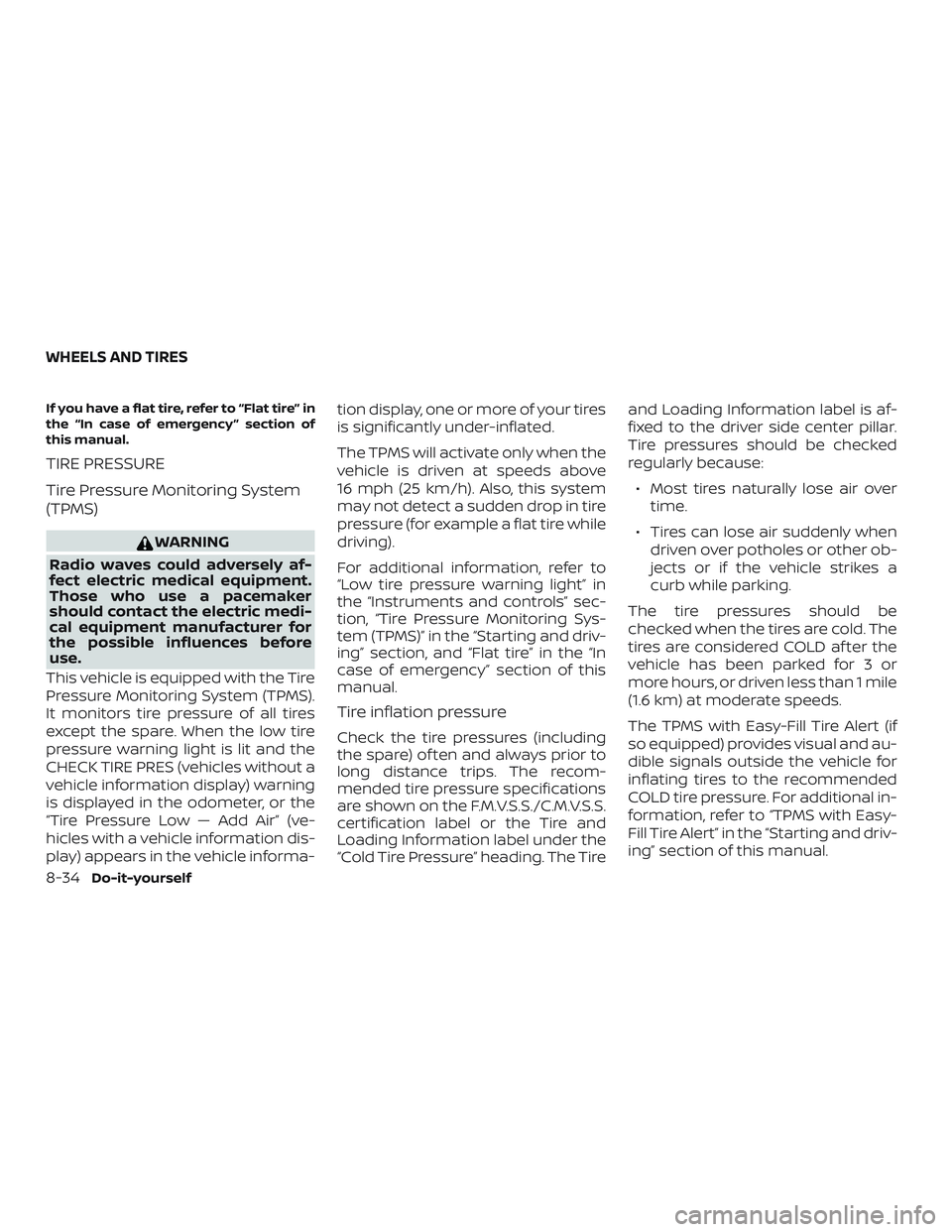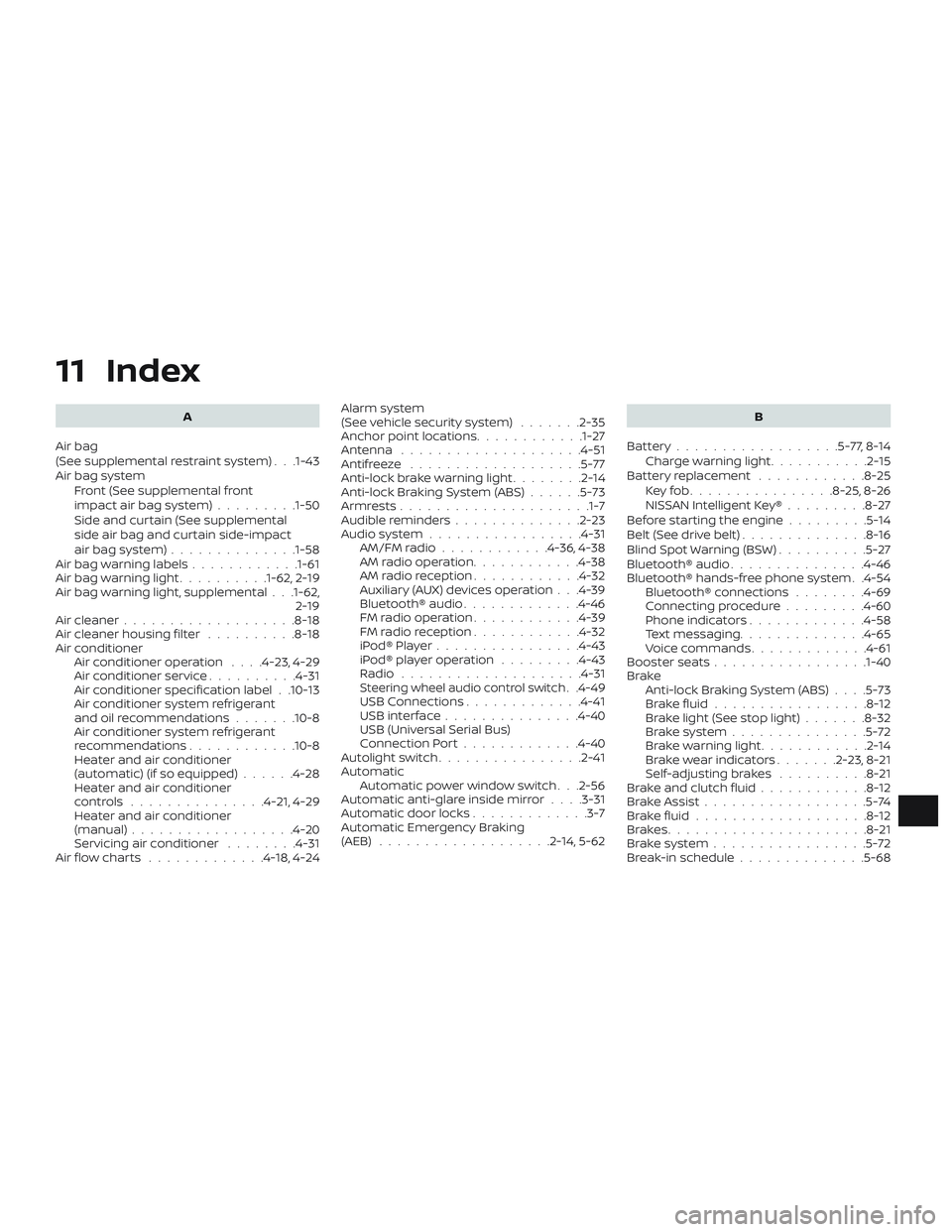2019 NISSAN SENTRA radio controls
[x] Cancel search: radio controlsPage 398 of 461

If you have a flat tire, refer to “Flat tire” in
the “In case of emergency ” section of
this manual.
TIRE PRESSURE
Tire Pressure Monitoring System
(TPMS)
WARNING
Radio waves could adversely af-
fect electric medical equipment.
Those who use a pacemaker
should contact the electric medi-
cal equipment manufacturer for
the possible influences before
use.
This vehicle is equipped with the Tire
Pressure Monitoring System (TPMS).
It monitors tire pressure of all tires
except the spare. When the low tire
pressure warning light is lit and the
CHECK TIRE PRES (vehicles without a
vehicle information display) warning
is displayed in the odometer, or the
“Tire Pressure Low — Add Air” (ve-
hicles with a vehicle information dis-
play) appears in the vehicle informa- tion display, one or more of your tires
is significantly under-inflated.
The TPMS will activate only when the
vehicle is driven at speeds above
16 mph (25 km/h). Also, this system
may not detect a sudden drop in tire
pressure (for example a flat tire while
driving).
For additional information, refer to
“Low tire pressure warning light” in
the “Instruments and controls” sec-
tion, “Tire Pressure Monitoring Sys-
tem (TPMS)” in the “Starting and driv-
ing” section, and “Flat tire” in the “In
case of emergency” section of this
manual.
Tire inflation pressure
Check the tire pressures (including
the spare) of ten and always prior to
long distance trips. The recom-
mended tire pressure specifications
are shown on the F.M.V.S.S./C.M.V.S.S.
certification label or the Tire and
Loading Information label under the
“Cold Tire Pressure” heading. The Tireand Loading Information label is af-
fixed to the driver side center pillar.
Tire pressures should be checked
regularly because:
∙ Most tires naturally lose air over time.
∙ Tires can lose air suddenly when driven over potholes or other ob-
jects or if the vehicle strikes a
curb while parking.
The tire pressures should be
checked when the tires are cold. The
tires are considered COLD af ter the
vehicle has been parked for 3 or
more hours, or driven less than 1 mile
(1.6 km) at moderate speeds.
The TPMS with Easy-Fill Tire Alert (if
so equipped) provides visual and au-
dible signals outside the vehicle for
inflating tires to the recommended
COLD tire pressure. For additional in-
formation, refer to “TPMS with Easy-
Fill Tire Alert” in the “Starting and driv-
ing” section of this manual.
WHEELS AND TIRES
8-34Do-it-yourself
Page 449 of 461

11 Index
A
Air bag
(See supplemental restraint system) . . .1-43
Air bag system Front (See supplemental front
impact air bag system) .........1-50
Side and curtain (See supplemental
side air bag and curtain side-impact
airbagsystem)............. .1-58
Air bag warning labels ............1-61
Airbagwarninglight..........1-62, 2-19
Air bag warning light, supplemental . . .1-62, 2-19
Air cleaner ...................8-18
Air cleaner housing filter ..........8-18
Air conditioner Air conditioner operation ....4-23,4-29
Air conditioner service ..........4-31
Air conditioner specification label . .10-13
Air conditioner system refrigerant
and oil recommendations .......10-8
Air conditioner system refrigerant
recommendations ............10-8
Heater and air conditioner
(automatic) (if so equipped) ......4-28
Heater and air conditioner
controls ...............4-21,4-29
Heater and air conditioner
(manual) ..................4-20
Servicing air conditioner ........4-31
Air flow charts .............4-18,4-24 Alarm system
(See vehicle security system)
.......2-35
Anchor point locations ............1-27
Antenna ....................4-51
Antifreeze ...................5-77
Anti-lock brake warning light ........2-14
Anti-lock Braking System (ABS) ......5-73
Armrests.................... .1-7
Audible reminders ..............2-23
Audiosystem.................4-31 AM/FMradio............4-36,4-38
AM radio operation ............4-38
AMradioreception............4-32
Auxiliary (AUX) devices operation . . .4-39
Bluetooth® audio .............4-46
FM radio operation ............4-39
FMradioreception............4-32
iPod®Player................4-43
iPod® player operation .........4-43
Radio ....................4-31
Steering wheel audio control switch. .4-49
USB Connections .............4-41
USBinterface...............4-40
USB (Universal Serial Bus)
Connection Port .............4-40
Autolightswitch................2-41
Automatic Automatic power window switch . . .2-56
Automatic anti-glare inside mirror ....3-31
Automatic door locks .............3-7
Automatic Emergency Braking
(AEB) ...................2-14,5-62 B
Battery..................5-77,8-14 Charge warning light ...........2-15
Battery replacement ............8-25
Keyfob................8-25,8-26
NISSAN Intelligent Key® .........8-27
Before starting the engine .........5-14
Belt(Seedrivebelt)..............8-16
Blind Spot Warning (BSW) ..........5-27
Bluetooth® audio ...............4-46
Bluetooth® hands-free phone system . .4-54 Bluetooth® connections ........4-69
Connecting procedure .........4-60
Phone indicators .............4-58
Text messaging ..............4-65
Voice commands .............4-61
Booster seats .................1-40
Brake Anti-lock Braking System (ABS) ....5-73
Brakefluid.................8-12
Brakelight(Seestoplight)....... 8-32
Brakesystem...............5-72
Brakewarninglight............2-14
Brakewearindicators.......2-23,8-21
Self-adjustingbrakes ..........8-21
Brakeandclutchfluid............8-12
Brake Assist ..................5-74
Brakefluid...................8-12
Brakes......................8-21
Brakesystem.................5-72
Break-in schedule ..............5-68
Page 450 of 461

Brightness/contrast button.........4-7
Brightness control Instrument panel .............2-44
Bulb check/instrument panel ........2-14
Bulb replacement ...............8-32
C
Capacities and recommended
fuel/lubricants.................10-2
Cargo (See vehicle loading information). .10-14
Car phone or CB radio ............4-54
Check tire press .................2-6
Check tire pressure ..............2-33
Childrestraints........1-20, 1-21, 1-23, 1-25 LATCH (Lower Anchors and Tethers for
CHildren)System..............1-25
Precautions on child
restraints.........1-23, 1-29, 1-35, 1-40
Top tether strap anchor point
locations.................. .1-27
Child safety rear door lock ..........3-7
Chimes, audible reminders .........2-23
Cleaningexteriorandinterior......7-2,7-4
Clockset.....................4-5
Clutch Clutchfluid.................8-12
C.M.V.S.S. certification label .........10-12
Coldweatherdriving.............5-77
Console box ..................2-52
Console light ..................2-60
Continuously Variable Transmission
(CVT) .....................5-9,5-17
Continuously Variable Transmission
(CVT) fluid ..................8-11 Driving with Continuously Variable
Transmission (CVT)
..........5-9,5-17
Control panel buttons .............4-3
Brightness/contrast button .......4-7
Controls Audio controls (steering wheel) ....4-49
Heater and air conditioner
controls................4-21,4-29
Coolant Capacities and recommended
fuel/lubricants...............10-2
Changing engine coolant .........8-7
Checking engine coolant level ......8-6
Engine coolant temperature gauge. . .2-7
Corrosionprotection..............7-8
Cruisecontrol.................5-45
Cupholders...............2-53,2-54
Curtain side-impact air bag system
(See supplemental side air bag and
curtain side-impact air bag system) . . . .1-58
D
Daytime Running Light System . . .2-43, 2-44
Defroster switch Rear window and outside mirror
defrosterswitch..............2-40
Dimensions and weights ..........10-10
Dimmer switch for instrument panel . . .2-44
Display controls
(see control panel buttons) ..........4-3
Door locks ....................3-5
Door open warning light ...........2-15
Drivebelt ....................8-16 Driving
Coldweatherdriving...........5-77
Driving with Continuously Variable
Transmission (CVT) ..........5-9,5-17
Driving with manual
transmission .............5-10,5-23
Precautions when starting and
driving .....................5-2
Driving the vehicle ...............5-17
E
E-CALL (SOS) SWITCH .............2-48
ECO mode switch ...............5-26
Economy - fuel .................5-70
Emergency engine shutoff ..........5-13
Emission control information label . . . .10-12
Emission control system warranty . . . .10-20
Engine Before starting the engine ........5-14
Capacities and recommended
fuel/lubricants...............10-2
Changing engine coolant .........8-7
Changing engine oil ............8-8
Changing engine oil filter .........8-10
Checking engine coolant level ......8-6
Checking engine oil level .........8-7
Engine compartment check
locations...................8-3
Engine coolant temperature gauge. . .2-7
Engine cooling system ..........8-5
Engine oil ...................8-7
Engine
oil and oil filter
recommendation .............10-7
Engine oil pressure warning light ....2-15
11-2